In: political art
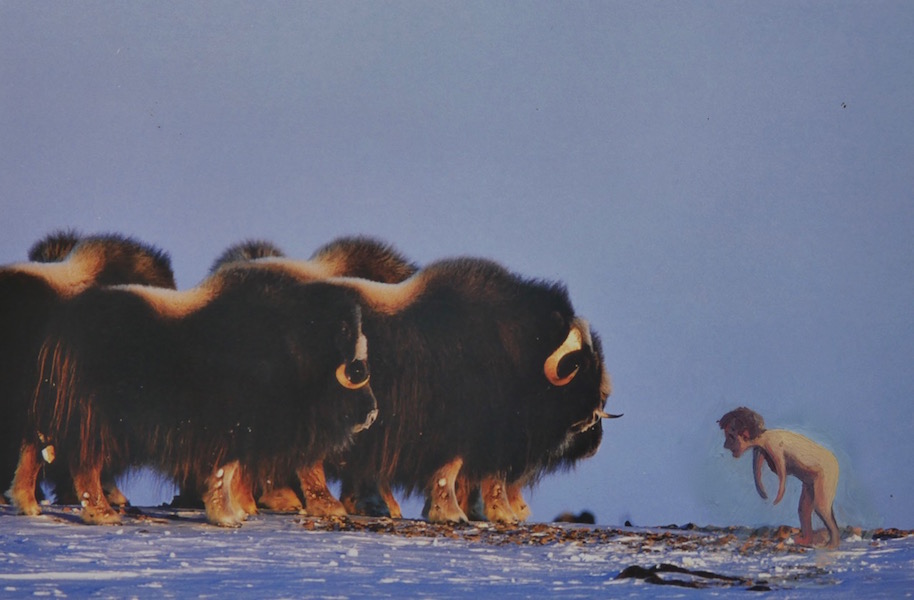
Bison Greeting (detail from Wildlife) | Sunaura Taylor, 2014
February 10, 2023Bison Greeting (detail from Wildlife) | Sunaura Taylor, 2014
“And you took the patronizing tone of an animal-trainer. Have you any idea what it is like to be spoken to in the way people speak to animals? A fascinating experience. Gives you quite a new feeling about animals. They don’t know words, but they understand tones. The tone people usually use to animals is affectionate, but it has an undertone of ‘What a fool you are!’ I suppose an animal has to make up its mind whether it will put up with that nonsense for the food and shelter that goes with it, or show the speaker who’s boss. That’s what I did.”
(Robertson Davies, World of Wonders)
I was introduced to Sunaura Taylor’s artwork by a friend who is a minister, and whose ministry is often focused upon the vulnerable in our Niagara community. We often share artists that interest us back and forth, as my own knowledge of contemporary religious painters appeals to her more progressive sensibilities. This image has a specific resonance to me. After spending so much time on the Canadian prairie the history of the use and abuse of the buffalo – and ideas now that tie buffalos metaphorically to different ways of thinking about society and our actions within it (through an Indigenous lens) with an aim to being ‘better’ and more inclusive as citizens within nations states – are factors in looking at Taylor’s painting.
Taylor’s visual art is striking, offering narratives that are both personal and offer a wider commentary on contemporary society. She is the recipient of a 2008 Joan Mitchell Foundation Award.
Her words: “My paintings are not at all only about the body, but the body is inevitably an aspect of my relationship with whatever it is that I am seeing.”
More: “I also want to paint and see politics, because I was born into them. I have a rare congenital disability called Arthrogryposis that was caused by toxic waste contamination in our groundwater, from the world’s largest polluter, the US military. I use a wheelchair for mobility and my mouth to paint. I grew up in a household of artists and anti-war activists, which perhaps made the knowledge that my body was formed by the industry of war, even more traumatic. I began at twelve to express myself and deal with these emotions through paint.”
Both quotes are from here, and I encourage you to visit that site to consider more of her erudite commentary, and see more of her paintings there.
“Sunaura Taylor is an artist, writer, academic, and an activist for both disability rights and animal rights. Her artwork has been displayed internationally and she is currently an assistant professor at UC Berkeley where she teaches classes in animal studies and environmental justice.
Taylor utilizes her lived experience as a disabled person to present new ways of thinking about disability and animals. Through each strand of her multifaceted work, she examines and challenges what it is to be human, what it is to be animal, and how the exploitation and oppression of both are entwined.” (from here)
While considering Taylor’s work, I was also reading Becoming Kin: An Indigenous Call to Unforgetting the Past and Reimagining Our Future by Patty Krawec (interestingly, this book was suggested to me by the same friend who introduced me to Taylor’s artwork): there is a story she relates that I’d like to end with, as a final response to Bison Greeting.
“In the spring, the people laid their tobacco on the ground as an offering, and they prayed and sang. Then they sent out runners in the four directions looking for the deer. These runners ran and ran, covering great distances, and one by one they returned. Nothing. Nothing. Nothing. Finally—maybe because this is how it is in stories—the last runner came back and said she had found one young deer, far to the north. This young one had told her that the deer had felt disrespected and threatened. So they left.
The young deer explained that initially they had waited to see if the humans would remember what we knew. But seeing from our behavior that we had no interest in relationship, and no interest in maintaining the agreements we had made with them, they left. This must have been a difficult decision because of the promise that they had made to the Creator that they would take care of us. The deer needed to think about their own survival, though. If we killed them all, they wouldn’t be here to take care of us anyway.
The people sent their diplomats, their elders, and their ceremonial people to meet with the deer, and for as much time as it took, they listened. They listened to the stories and to the harm they had done. They listened to old relationships and memory. They listened to how things should be. They made offerings and agreements.
Only then did the deer return to them. The people agreed to live in respect for the deer. They agreed to take care of the relationship that takes care of them.”
More of Sunaura Taylor’s artwork and writing can be found here and here.
~ Bart Gazzola
Read More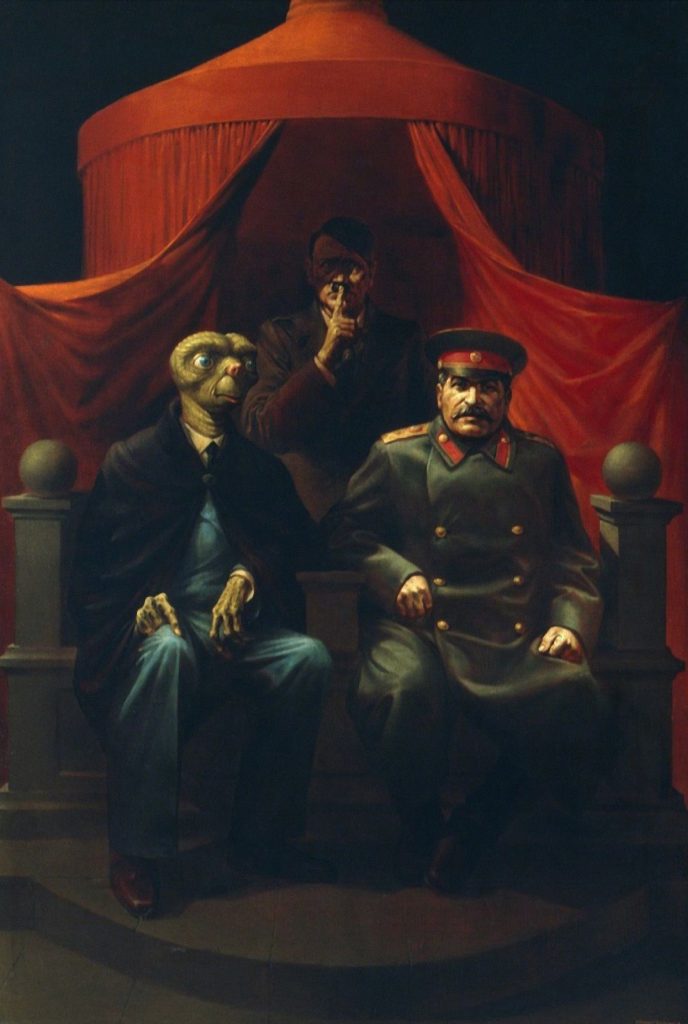
Komar and Melamid | Yalta Conference, 1982
January 26, 2023Komar and Melamid, Yalta Conference, from the “Nostalgic Socialist Realism” series, 1982
I enjoy speculative fiction and recently was reading Harry Turtledove’s Joe Steele. It’s a stand alone story, but you may be familiar with his Southern Victory series (in which the Confederate States survive the American Civil War, and it stretches into the mid twentieth century, offering alternate – yet familiar – takes on everything from WW I to the Holocaust) or World War / Colonization books. That series of books inject an alien invasion into the midst of WW II. This might sound ludicrous, until you read them and one of the aliens observes that – upon their discovery of Buchenwald and Auschwitz – that clearly humans are monstrously incapable of governing ‘ourselves.’ It’s an interesting tonic to the proliferation of science fiction that posits an alien deus ex machina that proffers the narrative that humans are special – such as Arthur C. Clarke’s Childhood’s End, for example. Perhaps it’s because Clarke was more hopeful, and much has happened since then…
“The novel [Joe Steele] explores what might have happened had Joseph Stalin been raised in the United States, postulating his parents having emigrated a few months before his birth, instead of remaining in the Russian Empire. It depicts Stalin (in this history, taking the name Joe Steele) growing up to be an American politician, rising to the presidency and retaining it by ruthless methods through the Great Depression, World War II, and the early Cold War. The president is depicted as having the soul of a tyrant, with Stalin’s real-world career mirrored by actions taken by Steele.” (from here)
But I mention Turtledove’s Joe Steele as it reminded me of Komar and Melamid’s painting Yalta Conference, from the Nostalgic Socialist Realism series, 1982. This work has also been the cover image for Boris Groys’ seminal book The Total Art of Stalinism: Avant-Garde, Aesthetic Dictatorship, and Beyond (2011). The ‘inspiration’ for this painting is a famous photograph.
Komar & Melamid are interesting for their cultivated personas as much as their art. This painting can’t help but offer and foment a myriad of interpretations, drawing upon not just the ‘players’ but the moment it re imagines. Yalta was, after all, the point at which the shaky alliance between the USSR and the United States began to seriously fracture. The employment – or appropriation – of ‘socialist realism’ (a style that was the official style of the USSR but that – to quote a Soviet born historian – was like Pravda, in that you can find some grain of truth by what it ignores) only makes this a ‘scene’ even more about failure (like the Yalta Conference was, towards any peace in a Post WW II world) than progress, with a sprinkling of absurdity and skepticism, with the hushing Hitler and American leader a goggle eyed alien….
Boris Groys, in writing about Komar and Melamid, offered the following about their aesthetic: “[The artists] themselves, however, perceive no sacrilege whatever here, because they consider the religion of the avant-garde to be false and idolatrous.”
More from Groys, that could also apply to this painting, and the multiplicities of potential interpretations of it (combined with the irreverence of Komar and Melamid’s larger practice): “[in] the West, the march of progress is “aimless” – one fashion succeeds another, one technical innovation replaces another and so on. The consciousness that desires a goal, meaning, harmony, or that simply refuses to serve the indifferent Moloch of time is inspired to rebel against this progress. Yet the movement of time has resisted all rebellions and attempts to confer meaning upon, control, or transcend it.”
More of Komar & Melamid’s work – and their unique aesthetic and legacy – can be enjoyed here. If you’re interested, more about Boris Groys’ writings and ideas can be read here.
~ Bart Gazzola
Read More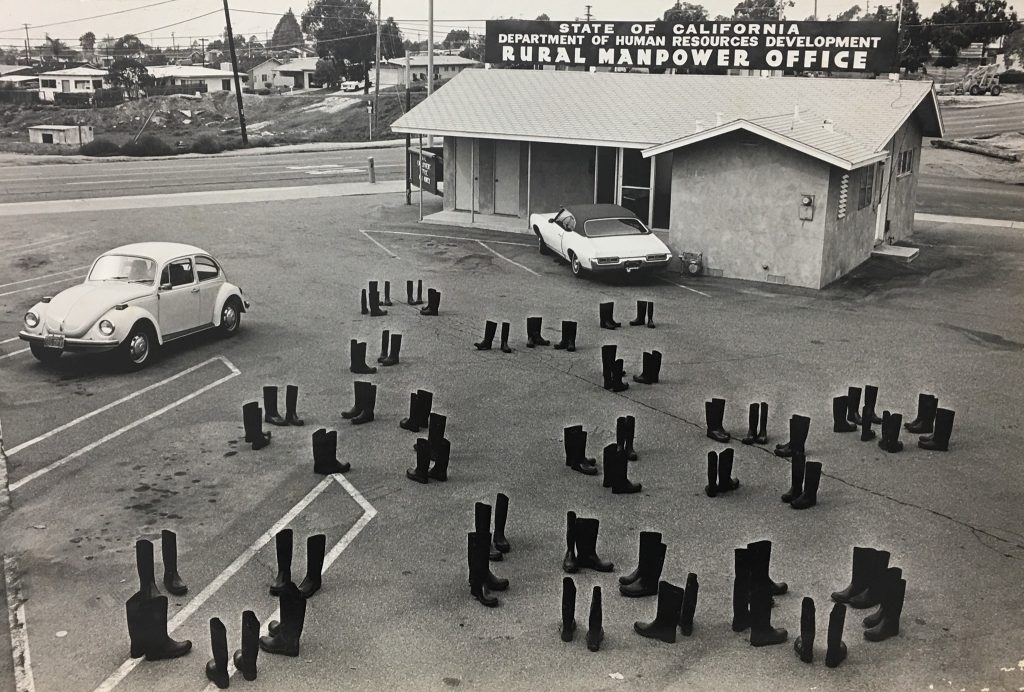
Eleanor Antin | 100 Boots, 1971-73
October 28, 2022Eleanor Antin | 100 Boots, 1971-73
“For month after month after month, her five-score empty rubber boots had to be carted across the country, set up in various evocative spots, and then photographed before someone could come along and chase Antin away…at the time, the empty boots would have had immediate resonance as a reference to the Vietnam War, and to the boot-wearers who would never come home.” (Blake Gopnik)
Eleanor Antin is an artist who has not, in my opinion, received the credit she merits for her performative installations and photographs that have a cinematic quality. At the risk of being flippant, if Gopnik, Camille Paglia and I myself all agree as to her importance, we surely can’t be wrong. Antin has been making work since the 1960s, and her art often intersects with politics in both overt and covert ways.
From Paglia’s Glittering Images: A Journey through Art from Egypt to Star Wars: ‘As a work of Conceptual art, 100 Boots consisted of temporary on-site sculptural installations documented by photographs (taken by Philip Steinmetz), which were sent uninvited to a distant, dispersed audience. The formal, squadron-like patterns assumed by the boots parody the frigid geometries then being made by male Minimalist sculptors. In their outdoor placement, the boots evoke traditional landscape painting as well as the new genre of land art, which was just emerging from Minimalism. Antin strategically varied the look of the cards so that “seductively beautiful” images were not the rule. Most of them have a bleak desolation reminiscent of existential European art films. Indeed, Antin saw the work as “a movie composed of still photos”.’
Over her career, Antin ‘has utilized a staggering range of styles, media, and materials, and her work has combined theater, dance, literature, drawing, painting, sculpture, crafts, photography, video, and architecture. “All artworks are conceptual machines,” she said. And again: “All art exists in the mind.” Antin deeply influenced the emergence of both performance art and Conceptual photography.’
For myself, these images are about the insidious nature of loss, especially as it pertains to those who have died during the pandemic. Empty boots that take on the nature of ghosts that appear in any place at any time, a simple – almost banal, like a rubber boot – fact of absence that hits you like a hammer to the chest and requires you to sit down to consider it….
Eleanor Antin was a previously featured Artist You Need To Know, in AIH Studios’ continuing series. That can be enjoyed here.
More works from this series can be seen here.
~ Bart Gazzola
Read More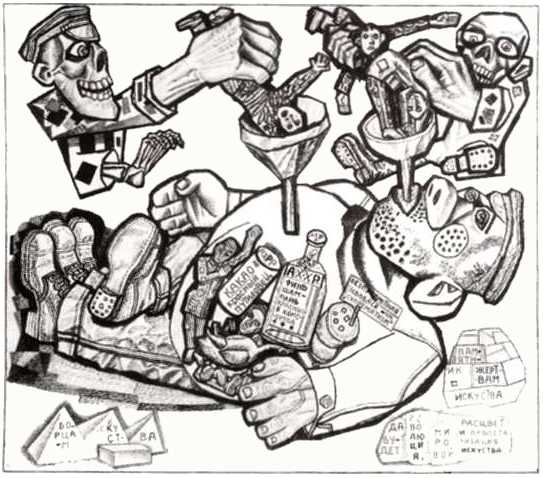
Pavel Filonov | The Formula of Contemporary Pedagogy of IZO, 1923
October 21, 2022Pavel Filonov | The Formula of Contemporary Pedagogy of IZO, 1923
He was walking about with a noose round his neck and didn’t know. So I told him what I’d heard about his poems.
. . . . . . . .
Yevgraf: This is a new edition of the Lara poems.
Engineer: Yes, I know. We admire your brother very much.
Yevgraf: Yes, everybody seems to.. now.
Engineer: Well, we couldn’t admire him when we weren’t allowed to read him…
Yevgraf: …No.
(both quotes from Boris Pasternak’s tale of Russia before and after the Russian Revolution Dr. Zhivago)
A defining book in my reading and understanding of art history in the 20th century is Boris Groys’ The Total Art of Stalinism: begun when the USSR was still in existence, Groys was able, with the fall of that empire, to access more information, and offer a more nuanced take upon the years post Russian Revolution, as it pertains to the arts in that rare and unique historical moment. Amusingly, I became aware of it after participating in a panel about modernism, and horrifying my fellow speakers by stating that it had failed, horribly, but that its relevance was in its ideals…
Several points stay with me, in considering Pavel Filonov’s work. One is that, in a correlation to the backward economic state of Russia making it fertile ground for a radical new approach and the subsequent revolution, the artistic milieu also suffered from this. It’s not incidental that so many significant artists – not just to Russia but to ‘western’ art history – like Malevich or the Suprematists flourished during the first heady days of the NEP. Experimentation and a sentiment that ‘anything was possible’ was pervasive and defining, with a desire to irrevocably fracture from the ‘old.’
This, of course, all ended badly, and the promised freedoms – whether artistic or personal – were soon not just reigned in, but suppressed, and a cultural exodus from the USSR to other places was predictable.
Filonov (1883 – 1941) served in WWI and would die of starvation during the siege of Leningrad, the once and present St. Petersburg, in the war that followed the ‘war to end all wars.’
The painter, art theorist and poet was an outsider, even during the pre and immediately post revolutionary days of promise: after several failures, in “1908 Filonov was admitted at last to the Academy of Arts. His works attracted the attention of both students and professors by their unusualness: they were not abstract and depicted their subject with full likeness, but were executed in garish, bright colors – reds, blues, greens and oranges. This manner did not conform to the Academy standards, and Filonov was dismissed “for influencing students with the lewdness of his work”. Filonov protested the decision of the rector Beklemishev, and was rehabilitated, but after studying for two years he left the Academy in 1910.”
He was one of many whose works were deemed degenerate, as they eschewed official socialist realist policy. He’d be lost to us, in terms of history, but for the efforts of his sister Yevdokiya Nikolayevna Glebova: “She stored the paintings in the Russian Museum’s archives and eventually donated them as a gift. Exhibitions of Filonov’s work were forbidden. In 1967, an exhibition of Filonov’s works in Novosibirsk was permitted. In 1988, his work was allowed in the Russian Museum. In 1989 and 1990, the first international exhibition of Filonov’s work was held in Paris.
During the period of half-legal status of Filonov’s works it was seemingly easy to steal them; however, there was a legend that Filonov’s ghost protected his art and anybody trying to steal his paintings or to smuggle them abroad would soon die, become paralyzed, or have a similar misfortune.”
It’s unsurprising that Filonov was deeply influence by fellow dissident Klebnikov: and his works – whether the obvious disdain present in this piece The Formula of Contemporary Pedagogy of IZO, or the more stark Those Who Have Nothing To Lose, or Animals, that would make a fine illustration for Orwell’s Animal Farm decades later – have an unflinching quality.
More of Filinov’s life and legacy can be learned here (and was the source cited for the biographical quotes about his life and work).
~ Bart Gazzola
Read More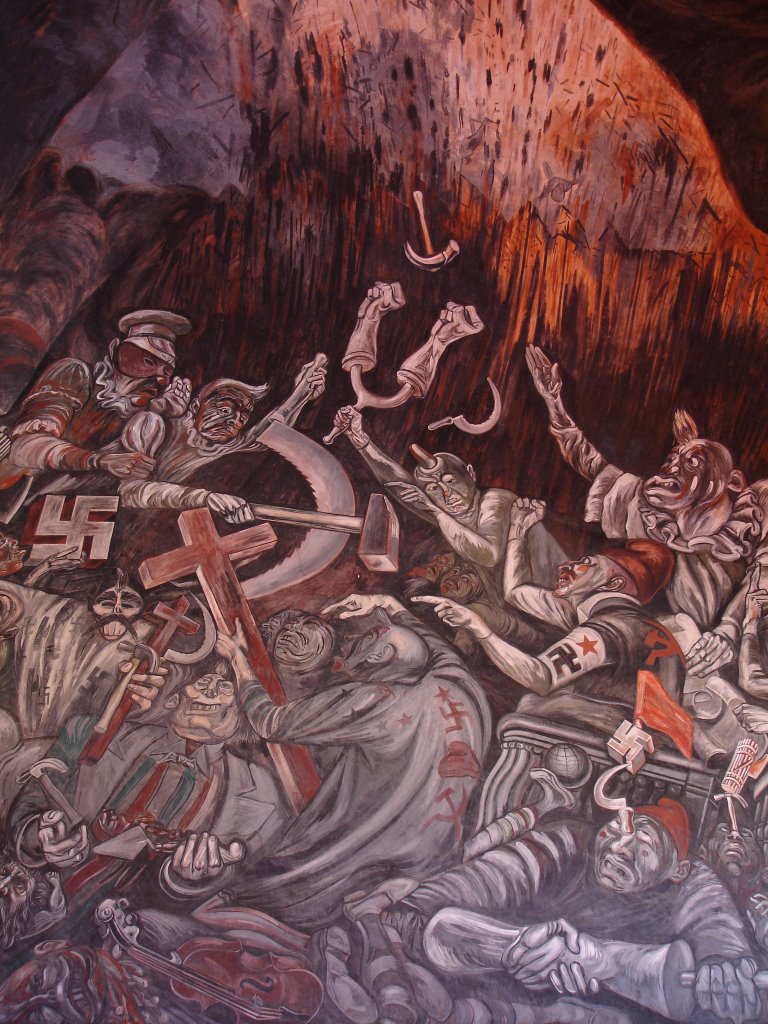
José Clemente Orozco | The Clowns of War Arguing in Hell, 1944
October 6, 2022José Clemente Orozco | The Clowns of War Arguing in Hell, 1944
Fresco, Palacio de Gobierno, Guadalajara (alternately known as Carnival of the Ideologies).
Do I look like the kind of clown that could start a movement? (from the film Joker, 2019)
And butchered, frantic gestures of the dead. (Siegfried Sassoon, 1886 – 1967)
This fresco, created only five years before the artist’s death, is a good example of how ‘Orozco’s late works were characterized by a deep sense of anguish and pessimism as the artist grew skeptical about the future of humanity in the wake of sweeping technological advancements.’ (from here) The facile art historical reading is that this work was Orozco’s reaction to WWII, but even a quick perusal of his impressive body of work, and the cultural and social milieu he existed within, will indicate that this is a more complex and personal artwork than that.
It is, bluntly, a horrifying piece, and intended to be so: painted in the final days of WW II, one might see this as the answer to that image of the conference at Yalta, with FDR, Churchill and Stalin, still pretending to be allies and not with their knives out to gluttonously divide the spoils of war.
Recently I was lucky enough to write about the work of Orozco’s colleague Rufino Tamayo, who eschewed the political discourse that this artist – and other contemporaries like Diego Rivera or David Alfaro Siqueiros – considered essential to Mexican art. Orozco is at the opposite end of this spectrum from Tamayo: in this regard, Octavio Paz [the internationally renowned essayist and poet] once remarked “Orozco never smiled in his life.” (from here) Perhaps that is because – as with this work – Orozco had little use for genteel diplomacy, and knew that once you saw horrors, it was a conscious act of morality to not look away….I am also researching the Russian – Canadian artist Paraskeva Clark, right now, and her aesthetic was to respond to, and reflect, the world she lived within. That is what Orozco is doing here.
But if I’m honest, the reason this older work holds my attention now and I want to share it here is because it seems that very little has changed, in our political discourse, and that we’re still – willingly or press-ganged – onto Das Narrenschiff [A Ship of Fools], a favourite theme of Hieronymous Bosch and so many others….
A quick perusal of the civic candidates standing for office in my space of Niagara only emphasizes this appropriate cynicism.
Much more about Orozco’s life and legacy can be seen here.
~ Bart Gazzola
Read More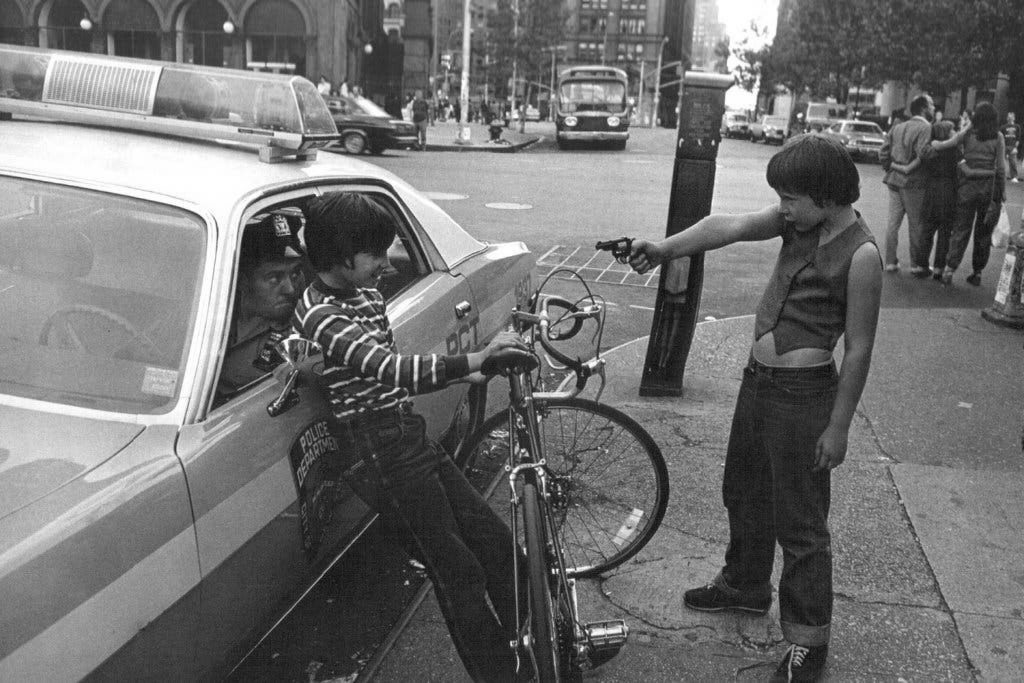
Gun Play | Jill Freedman
August 8, 2022Jill Freedman is a name you should know in the world of photography… but more than likely don’t. With a career that spanned 40 years, 7 (and counting) books and pieces acquired by major galleries, Freedman’s work connects deeply with her subjects in a manner unlike most documentary photographers.
From the very beginning, Jill was IN. She didn’t go to take photos of Resurrection City in Washington in 1968; she LIVED in the camp with the protesters for the duration of that campaign. She travelled with the circus for several months in the early 70’s to get her incredible photos of life under and around the big top. She embedded herself in the firehouses and police precincts of NYC and came out with work so beautiful and intimate that her two books on the subjects (Firehouse and Street Cops) were snapped up by first responders when they were re-released in the early 2000’s.
When Pulitzer Prize winner Studs Terkel wrote his oral history Working in 1974, Jill Freedman was who he interviewed when talking about photographers. From the first time I saw her work, I knew that there was an extreme tension in how she approached it. “Sometimes it’s hard to get started, ’cause I’m always aware of invading privacy. If there’s someone who doesn’t want me to take their picture, I don’t. When should you shoot and when shouldn’t you? I’ve gotten pictures of cops beating people. Now they didn’t want their pictures taken. (Laughs.) That’s a different thing.”[i] Freedman walked a very thin line between rooting for the underdog yet respecting authority.
You can find out more about Jill Freedman at http://www.jillfreedman.com/. Resurrection City, 1968 was recently re-published and can be found for purchase at your favorite bookstore or online. Firehouse and Street Cops are no longer in print, but used copies can be found online.
[i] Working: People Talk About What They Do All Day and How They Feel About What They Do by Studs Terkel Text © 1972, 1974 by Studs Terkel – The New Press, New York, 2004, Pg. 153-154
~ Mark Walton
Read More
Recent Comments